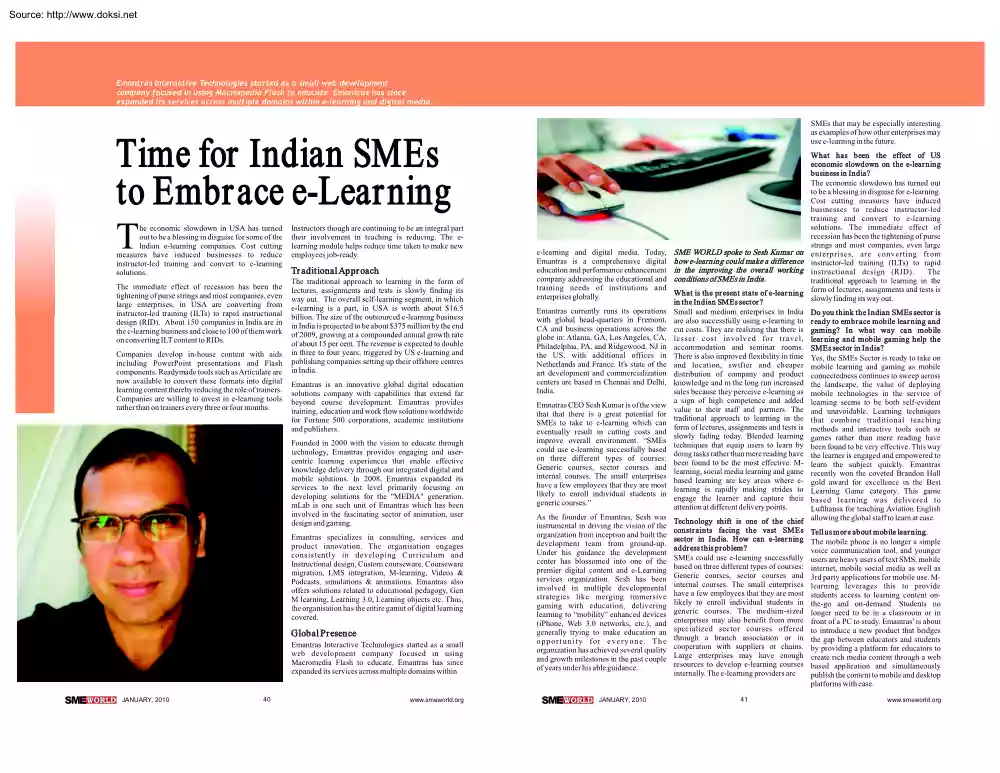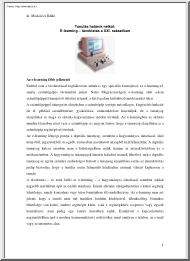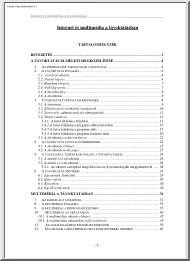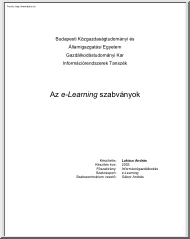Datasheet
Year, pagecount:2010, 1 page(s)
Language:English
Downloads:2
Uploaded:December 11, 2017
Size:613 KB
Institution:
-
Comments:
Attachment:-
Download in PDF:Please log in!
Comments
No comments yet. You can be the first!Content extract
Source: http://www.doksinet Emantras Interactive Technologies started as a small web development company focused in using Macromedia Flash to educate. Emantras has since expanded its services across multiple domains within e-learning and digital media. Time for Indian SMEs to Embrace e-Learning T he economic slowdown in USA has turned out to be a blessing in disguise for some of the Indian e-learning companies. Cost cutting measures have induced businesses to reduce instructor-led training and convert to e-learning solutions. The immediate effect of recession has been the tightening of purse strings and most companies, even large enterprises, in USA are converting from instructor-led training (ILTs) to rapid instructional design (RID). About 150 companies in India are in the e-learning business and close to 100 of them work on converting ILT content to RIDs. Companies develop in-house content with aids including PowerPoint presentations and Flash components. Readymade tools such as
Articulate are now available to convert these formats into digital learning content thereby reducing the role of trainers. Companies are willing to invest in e-learning tools rather than on trainers every three or four months. Instructors though are continuing to be an integral part their involvement in teaching is reducing. The elearning module helps reduce time taken to make new employees job-ready. TraditionalApproach The traditional approach to learning in the form of lectures, assignments and tests is slowly finding its way out. The overall self-learning segment, in which e-learning is a part, in USA is worth about $16.5 billion. The size of the outsourced e-learning business in India is projected to be about $375 million by the end of 2009, growing at a compounded annual growth rate of about 15 per cent. The revenue is expected to double in three to four years, triggered by US e-learning and publishing companies setting up their offshore centres in India. Emantras is an
innovative global digital education solutions company with capabilities that extend far beyond course development. Emantras provides training, education and work flow solutions worldwide for Fortune 500 corporations, academic institutions and publishers. Founded in 2000 with the vision to educate through technology, Emantras provides engaging and usercentric learning experiences that enable effective knowledge delivery through our integrated digital and mobile solutions. In 2008, Emantras expanded its services to the next level primarily focusing on developing solutions for the "MEDIA" generation. mLab is one such unit of Emantras which has been involved in the fascinating sector of animation, user design and gaming. Emantras specializes in consulting, services and product innovation. The organisation engages consistently in developing Curriculum and Instructional design, Custom courseware, Courseware migration, LMS integration, M-learning, Videos & Podcasts, simulations
& animations. Emantras also offers solutions related to educational pedagogy, Gen M learning, Learning 3.0, Learning objects etc Thus, the organisation has the entire gamut of digital learning covered. GlobalPresence JANUARY, 2010 Sesh Kumar Emantras Interactive Technologies started as a small web development company focused in using Macromedia Flash to educate. Emantras has since expanded its services across multiple domains within 40 www.smeworldorg SMEs that may be especially interesting as examples of how other enterprises may use e-learning in the future. What has been the effect of US economic slowdown on the e-learning businessin India? e-learning and digital media. Today, Emantras is a comprehensive digital education and performance enhancement company addressing the educational and training needs of institutions and enterprises globally. Emantras currently runs its operations with global head-quarters in Fremont, CA and business operations across the globe in:
Atlanta, GA, Los Angeles, CA, Philadelphia, PA, and Ridgewood, NJ in the US, with additional offices in Netherlands and France. Its state of the art development and commercialization centers are based in Chennai and Delhi, India. Emnatras CEO Sesh Kumar is of the view that that there is a great potential for SMEs to take to e-learning which can eventually result in cutting costs and improve overall environment. “SMEs could use e-learning successfully based on three different types of courses: Generic courses, sector courses and internal courses. The small enterprises have a few employees that they are most likely to enroll individual students in generic courses.” As the founder of Emantras, Sesh was instrumental in driving the vision of the organization from inception and built the development team from ground-up. Under his guidance the development center has blossomed into one of the premier digital content and e-Learning services organization. Sesh has been involved in multiple
developmental strategies like merging immersive gaming with education, delivering learning to “mobility” enhanced devices (iPhone, Web 3.0 networks, etc), and generally trying to make education an opportunity for everyone. The organization has achieved several quality and growth milestones in the past couple of years under his able guidance. JANUARY, 2010 SME WORLD spoke to Sesh Kumar on howe-learning could make a difference in the improving the overall working conditionsofSMEsin India. What is the present state of e-learning in theIndian SMEssector? Small and medium enterprises in India are also successfully using e-learning to cut costs. They are realizing that there is lesser cost involved for travel, accommodation and seminar rooms. There is also improved flexibility in time and location, swifter and cheaper distribution of company and product knowledge and in the long run increased sales because they perceive e-learning as a sign of high competence and added value to their
staff and partners. The traditional approach to learning in the form of lectures, assignments and tests is slowly fading today. Blended learning techniques that equip users to learn by doing tasks rather than mere reading have been found to be the most effective. Mlearning, social media learning and game based learning are key areas where elearning is rapidly making strides to engage the learner and capture their attention at different delivery points. The economic slowdown has turned out to be a blessing in disguise for e-learning. Cost cutting measures have induced businesses to reduce instructor-led training and convert to e-learning solutions. The immediate effect of recession has been the tightening of purse strings and most companies, even large enterprises, are converting from instructor-led training (ILTs) to rapid instructional design (RID). The traditional approach to learning in the form of lectures, assignments and tests is slowly finding its way out. Do you think the
Indian SMEs sector is ready to embrace mobile learning and gaming? In what way can mobile learning and mobile gaming help the SMEssector in India? Yes, the SMEs Sector is ready to take on mobile learning and gaming as mobile connectedness continues to sweep across the landscape, the value of deploying mobile technologies in the service of learning seems to be both self-evident and unavoidable. Learning techniques that combine traditional teaching methods and interactive tools such as games rather than mere reading have been found to be very effective. This way the learner is engaged and empowered to learn the subject quickly. Emantras recently won the coveted Brandon Hall gold award for excellence in the Best Learning Game category. This game based learning was delivered to Lufthansa for teaching Aviation English allowing the global staff to learn at ease. Technology shift is one of the chief constraints facing the vast SMEs Tellusmoreabout mobilelearning. sector in India. How can
e-learning The mobile phone is no longer a simple addressthisproblem? voice communication tool, and younger SMEs could use e-learning successfully based on three different types of courses: Generic courses, sector courses and internal courses. The small enterprises have a few employees that they are most likely to enroll individual students in generic courses. The medium-sized enterprises may also benefit from more specialized sector courses offered through a branch association or in cooperation with suppliers or chains. Large enterprises may have enough resources to develop e-learning courses internally. The e-learning providers are 41 users are heavy users of text SMS, mobile internet, mobile social media as well as 3rd party applications for mobile use. Mlearning leverages this to provide students access to learning content onthe-go and on-demand. Students no longer need to be in a classroom or in front of a PC to study. Emantras is about to introduce a new product that bridges
the gap between educators and students by providing a platform for educators to create rich media content through a web based application and simultaneously publish the content to mobile and desktop platforms with ease. www.smeworldorg
Articulate are now available to convert these formats into digital learning content thereby reducing the role of trainers. Companies are willing to invest in e-learning tools rather than on trainers every three or four months. Instructors though are continuing to be an integral part their involvement in teaching is reducing. The elearning module helps reduce time taken to make new employees job-ready. TraditionalApproach The traditional approach to learning in the form of lectures, assignments and tests is slowly finding its way out. The overall self-learning segment, in which e-learning is a part, in USA is worth about $16.5 billion. The size of the outsourced e-learning business in India is projected to be about $375 million by the end of 2009, growing at a compounded annual growth rate of about 15 per cent. The revenue is expected to double in three to four years, triggered by US e-learning and publishing companies setting up their offshore centres in India. Emantras is an
innovative global digital education solutions company with capabilities that extend far beyond course development. Emantras provides training, education and work flow solutions worldwide for Fortune 500 corporations, academic institutions and publishers. Founded in 2000 with the vision to educate through technology, Emantras provides engaging and usercentric learning experiences that enable effective knowledge delivery through our integrated digital and mobile solutions. In 2008, Emantras expanded its services to the next level primarily focusing on developing solutions for the "MEDIA" generation. mLab is one such unit of Emantras which has been involved in the fascinating sector of animation, user design and gaming. Emantras specializes in consulting, services and product innovation. The organisation engages consistently in developing Curriculum and Instructional design, Custom courseware, Courseware migration, LMS integration, M-learning, Videos & Podcasts, simulations
& animations. Emantras also offers solutions related to educational pedagogy, Gen M learning, Learning 3.0, Learning objects etc Thus, the organisation has the entire gamut of digital learning covered. GlobalPresence JANUARY, 2010 Sesh Kumar Emantras Interactive Technologies started as a small web development company focused in using Macromedia Flash to educate. Emantras has since expanded its services across multiple domains within 40 www.smeworldorg SMEs that may be especially interesting as examples of how other enterprises may use e-learning in the future. What has been the effect of US economic slowdown on the e-learning businessin India? e-learning and digital media. Today, Emantras is a comprehensive digital education and performance enhancement company addressing the educational and training needs of institutions and enterprises globally. Emantras currently runs its operations with global head-quarters in Fremont, CA and business operations across the globe in:
Atlanta, GA, Los Angeles, CA, Philadelphia, PA, and Ridgewood, NJ in the US, with additional offices in Netherlands and France. Its state of the art development and commercialization centers are based in Chennai and Delhi, India. Emnatras CEO Sesh Kumar is of the view that that there is a great potential for SMEs to take to e-learning which can eventually result in cutting costs and improve overall environment. “SMEs could use e-learning successfully based on three different types of courses: Generic courses, sector courses and internal courses. The small enterprises have a few employees that they are most likely to enroll individual students in generic courses.” As the founder of Emantras, Sesh was instrumental in driving the vision of the organization from inception and built the development team from ground-up. Under his guidance the development center has blossomed into one of the premier digital content and e-Learning services organization. Sesh has been involved in multiple
developmental strategies like merging immersive gaming with education, delivering learning to “mobility” enhanced devices (iPhone, Web 3.0 networks, etc), and generally trying to make education an opportunity for everyone. The organization has achieved several quality and growth milestones in the past couple of years under his able guidance. JANUARY, 2010 SME WORLD spoke to Sesh Kumar on howe-learning could make a difference in the improving the overall working conditionsofSMEsin India. What is the present state of e-learning in theIndian SMEssector? Small and medium enterprises in India are also successfully using e-learning to cut costs. They are realizing that there is lesser cost involved for travel, accommodation and seminar rooms. There is also improved flexibility in time and location, swifter and cheaper distribution of company and product knowledge and in the long run increased sales because they perceive e-learning as a sign of high competence and added value to their
staff and partners. The traditional approach to learning in the form of lectures, assignments and tests is slowly fading today. Blended learning techniques that equip users to learn by doing tasks rather than mere reading have been found to be the most effective. Mlearning, social media learning and game based learning are key areas where elearning is rapidly making strides to engage the learner and capture their attention at different delivery points. The economic slowdown has turned out to be a blessing in disguise for e-learning. Cost cutting measures have induced businesses to reduce instructor-led training and convert to e-learning solutions. The immediate effect of recession has been the tightening of purse strings and most companies, even large enterprises, are converting from instructor-led training (ILTs) to rapid instructional design (RID). The traditional approach to learning in the form of lectures, assignments and tests is slowly finding its way out. Do you think the
Indian SMEs sector is ready to embrace mobile learning and gaming? In what way can mobile learning and mobile gaming help the SMEssector in India? Yes, the SMEs Sector is ready to take on mobile learning and gaming as mobile connectedness continues to sweep across the landscape, the value of deploying mobile technologies in the service of learning seems to be both self-evident and unavoidable. Learning techniques that combine traditional teaching methods and interactive tools such as games rather than mere reading have been found to be very effective. This way the learner is engaged and empowered to learn the subject quickly. Emantras recently won the coveted Brandon Hall gold award for excellence in the Best Learning Game category. This game based learning was delivered to Lufthansa for teaching Aviation English allowing the global staff to learn at ease. Technology shift is one of the chief constraints facing the vast SMEs Tellusmoreabout mobilelearning. sector in India. How can
e-learning The mobile phone is no longer a simple addressthisproblem? voice communication tool, and younger SMEs could use e-learning successfully based on three different types of courses: Generic courses, sector courses and internal courses. The small enterprises have a few employees that they are most likely to enroll individual students in generic courses. The medium-sized enterprises may also benefit from more specialized sector courses offered through a branch association or in cooperation with suppliers or chains. Large enterprises may have enough resources to develop e-learning courses internally. The e-learning providers are 41 users are heavy users of text SMS, mobile internet, mobile social media as well as 3rd party applications for mobile use. Mlearning leverages this to provide students access to learning content onthe-go and on-demand. Students no longer need to be in a classroom or in front of a PC to study. Emantras is about to introduce a new product that bridges
the gap between educators and students by providing a platform for educators to create rich media content through a web based application and simultaneously publish the content to mobile and desktop platforms with ease. www.smeworldorg





 When reading, most of us just let a story wash over us, getting lost in the world of the book rather than paying attention to the individual elements of the plot or writing. However, in English class, our teachers ask us to look at the mechanics of the writing.
When reading, most of us just let a story wash over us, getting lost in the world of the book rather than paying attention to the individual elements of the plot or writing. However, in English class, our teachers ask us to look at the mechanics of the writing.